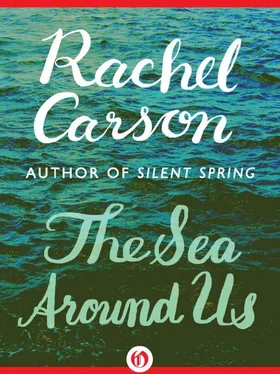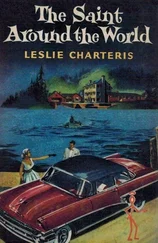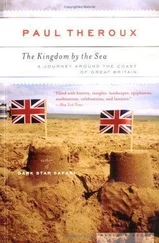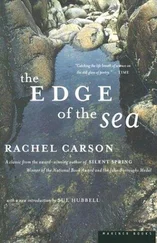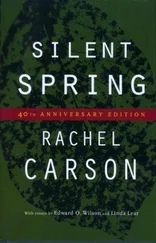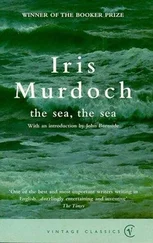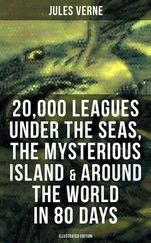As between tropical and polar regions, the differences in the kinds and abundance of life are tremendous. The warm temperatures of the tropics speed up the processes of reproduction and growth, so that many generations are produced in the time required to bring one to maturity in cold seas. There is more opportunity for genetic mutations to be produced within a given time; hence the bewildering variety of tropical life. Yet in any species there are far fewer individuals than in the colder zones, where the mineral content of the water is richer, and there are no dense swarms of surface plankton, like the copepods of the Arctic. The pelagic, or free-swimming, forms of the tropics live deeper than those of the colder regions, and so there is less food for large surface-feeders. In the tropics, therefore, the sea birds do not compare in abundance with the clouds of shearwaters, fulmars, auks, whalebirds, albatrosses, and other birds seen over far northern or far southern fishing grounds.
In the cold-water communities of the polar seas, fewer of the animals have swimming larvae. Generation after generation settle down near the parents, so that large areas of bottom may be covered with descendants of a very few animals. In the Barents Sea a research vessel once brought up more than a ton of one of the siliceous sponges at a single haul, and enormous patches of a single species of annelid worm carpet the east coast of Spitsbergen. Copepods and swimming snails fill the surface waters of the cold seas, and lure the herring and the mackerel, the flocks of sea birds, the whales, and the seals.
In the tropics, then, sea life is intense, vivid, and infinitely varied. In cold seas it proceeds at a pace slowed by the icy water in which it exists, but the mineral riches of these waters (largely a result of seasonal overturn and consequent mixing) makes possible the enormous abundance of the forms that inhabit them. For a good many years it has been said categorically that the total productivity of the colder temperate and polar seas is far greater than the tropical. Now it is becoming plain that there are important exceptions to this statement. In certain tropical and subtropical waters, there are areas where the sheer abundance of life rivals the Grand Banks or the Barents Sea or any antarctic whaling ground. Perhaps the best examples are the Humboldt Current, off the west coast of South America, and the Benguela Current, off the west coast of Africa. In both currents, upwelling of cold, mineral-laden water from deeper layers of the sea provides the fertilizing elements to sustain the great food chains.
And wherever two currents meet, especially if they differ sharply in temperature or salinity, there are zones of great turbulence and unrest, with water sinking or rising up from the depths and with shifting eddies and foam lines at the surface. At such places the richness and abundance of marine life reveals itself most strikingly. This changing life, seen as his ship cut across the pathways of the great currents of the Pacific and the Atlantic, was described with vivid detail by S. C. Brooks:
Within a few degrees of the equator, the scattered cumulus clouds become thicker and grayer, a confused swell makes up, rain squalls come and go, and birds appear. At first there is only a greater abundance of storm petrels, with here and there petrels of other kinds hunting along utterly indifferent to the ship, or small groups of tropic birds flying along with the ship, off to one side or high overhead. Then scattered groups of various petrels appear, and finally for an hour or two there are birds on every hand. If one is not too far from land, a few hundred miles perhaps, as in the case of the south equatorial drift north of the Marquesas, one may also see multitudes of sooty or crested terns. Occasionally one sees the grayish blue form of a shark gliding along, or a big purplish-brown hammerhead lazily twisting around as though trying to get a better view of the ship. Flying fish, while not so closely localized as the birds, are breaking the water every few seconds, and bewitch the beholder by their myriad sizes, shapes, and antics, and their bewildering patterns and shades of deep brown, opal blue, yellow and purple. Then the sun comes out again, the sea takes on its deep tropical blue, the birds become more and more scarce, and gradually, as the ship moves on, the ocean resumes its desert aspect.
If it were daylight all the time, this same sequence might be seen in a more or less striking fashion twice or perhaps even three or four times. Inquiry soon reveals that this sequence marks the time of passing the edge of one of the great currents…
In the North Atlantic ship lanes the same play is staged with different actors. Instead of the equatorial currents there are the Gulf Stream and its continuation, the North Atlantic Drift, and the Arctic Current; instead of confused swell and squalls of rain there are slicks and fogs. Tropicbirds are replaced by jaegers and skuas; and different species of the petrel group, usually here spoken of as shearwaters and fulmars, are flying or swimming about, often in great flocks… Here, too, perhaps, one sees less of sharks and more of porpoise racing with the cut-water or doggedly hurrying, school after school, toward some unguessable objective. The flashing black and white of the young orcas, or the distant sudden spurt and lazy drift of a whale’s spouting, lend life to the water, as do the antics of flying fish, distant though they be from their traditional home in the tropics… One may pass from the blue water of the Stream, with floating gulf weed (Sargassum), and perhaps here and there the iridescent float of a Portuguese man-of-war, into the gray-green water of the Arctic Current with its thousands of jelly fish, and in a few hours back again into the Stream. Each time, at the margin, one is likely to see the surface display of that abundance of life which has made the Grand Banks one of the great fisheries of the world. [3] From The Condor, vol. 36, no. 5, Sept.–Oct. 1934, pp. 186–7.
The mid-ocean regions, bounded by the currents that sweep around the ocean basins, are in general the deserts of the sea. There are few birds and few surface-feeding fishes, and indeed there is little surface plankton to attract them. The life of these regions is largely confined to deep water. The Sargasso Sea is an exception, not matched in the anticyclonic centers of other ocean basins. It is so different from any other place on earth that it may well be considered a definite geographic region. A line drawn from the mouth of Chesapeake Bay to Gibraltar would skirt its northern border; another from Haiti to Dakar would mark its southern boundary. It lies all about Bermuda and extends more than half-way across the Atlantic, its entire area being roughly as large as the United States. The Sargasso, with all its legendary terrors for sailing ships, is a creation of the great currents of the North Atlantic that encircle it and bring into it the millions of tons of floating sargassum weed from which the place derives its name, and all the weird assemblage of animals that live in the weed.
The Sargasso is a place forgotten by the winds, undisturbed by the strong flow of waters that girdle it as with a river. Under the seldom-clouded skies, its waters are warm and heavy with salt. Separated widely from coastal rivers and from polar ice, there is no inflow of fresh water to dilute its saltiness; the only influx is of saline water from the adjacent currents, especially from the Gulf Stream or North Atlantic Current as it crosses from America to Europe. And with the little, inflowing streams of surface water come the plants and animals that for months or years have drifted in the Gulf Stream.
The sargassum weeds are brown algae belonging to several species. Quantities of the weeds live attached to reefs or rocky outcroppings off the coasts of the West Indies and Florida. Many of the plants are torn away by storms, especially during the hurricane season. They are picked up by the Gulf Stream and are drifted northward. With the weeds go, as involuntary passengers, many small fishes, crabs, shrimps, and innumerable larvae of assorted species of marine creatures, whose home had been the coastal banks of sargassum weed.
Читать дальше
